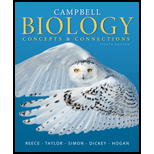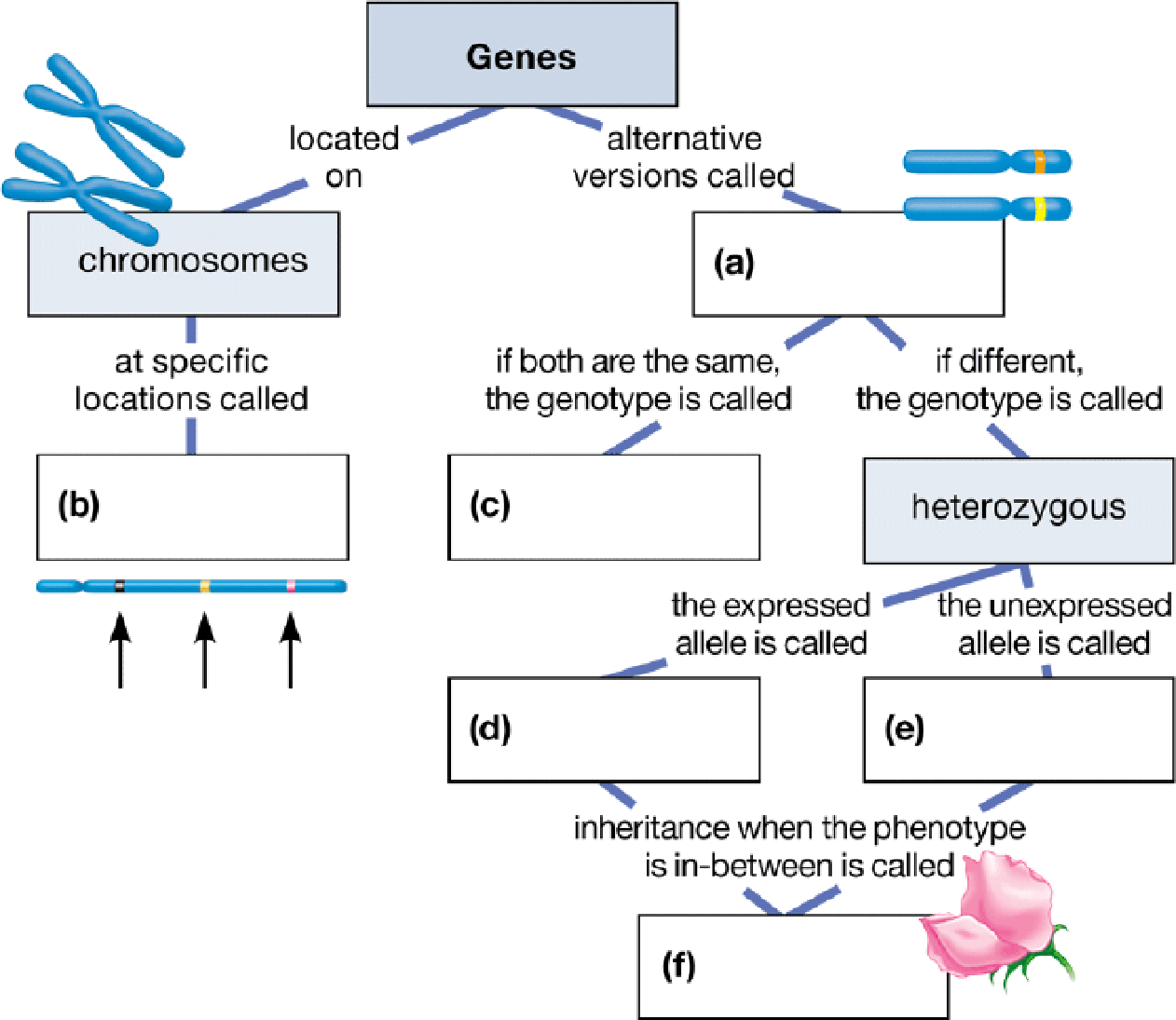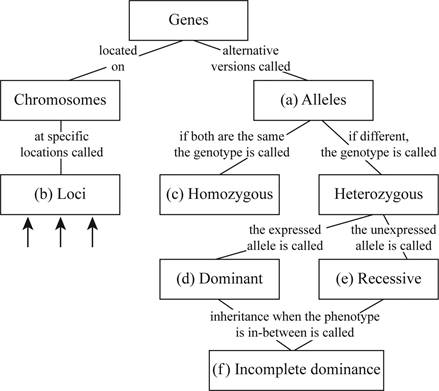
Concept explainers
Connecting the Concepts
1. Complete this concept map to help you review some key concepts of genetics.

To complete: The given map showing some key concepts of genetics.
Introduction: Genetics forms the basis of heredity. It is the study of genes, inheritance patterns, and their expression leading to various traits in living beings.
Answer to Problem 1CC
Pictorial representation: Fig. 1 shows the completed map key concepts of genetics.

Fig.1:Key concepts of genetics
Explanation of Solution
(a)
Correct answer: Alleles
Explanation: Genes have alternate forms known as alleles. The two alleles of a gene segregate into different gametes and are transmitted to offspring. Hence, the correct answer is alleles.
(b)
Correct answer: Loci
Explanation: Genes are DNA sequences that code for specific traits. The specific position of a gene on a chromosome is known as locus. The plural of locus is loci. Hence, the correct answer is loci.
(c)
Correct answer: Homozygous
Explanation: The alleles of a gene segregate into gametes and transmitted to offspring. They are dominant and recessive alleles. When the two alleles are same in an individual(either dominant or recessive), its genotype is homozygous. Hence, the correct answer is homozygous.
(d)
Correct answer: Dominant
Explanation: Dominance in alleles of a gene occurs when a phenotypic effect of one allele suppresses the phenotypic effect of a second allele. If the two alleles are different in an individual, then the dominant allele out of the two alleles expresses itself and determines the phenotype. Hence, the correct answer is dominant.
(e)
Correct answer: Recessive
Explanation: A dominant allele masks the expression of a second allele. The masked allele is known as recessive because its phenotypic effect is suppressed. Hence, the correct answer is recessive.
(f)
Correct answer: Incomplete dominance
Explanation: Dominance explains how different alleles of a gene express themselves. Some genes show incomplete dominance, which means that individuals with homozygous alleles produce offspring that is intermediate of the two parent alleles. Hence, the correct answer is incomplete dominance.
Want to see more full solutions like this?
Chapter 9 Solutions
Campbell Biology: Concepts & Connections (8th Edition)
- 18. Watch this short youtube video about SARS CoV-2 replication. SARS-CoV-2 Life Cycle (Summer 2020) - YouTube.19. What is the name of the receptor that SARS CoV-2 uses to enter cells? Which human cells express this receptor? 20. Name a few of the proteins that the SARS CoV-2 mRNA codes for. 21. What is the role of the golgi apparatus related to SARS CoV-2arrow_forwardState the five functions of Globular Proteins, and give an example of a protein for each function.arrow_forwardDiagram of check cell under low power and high powerarrow_forward
- a couple in which the father has the a blood type and the mother has the o blood type produce an offspring with the o blood type, how does this happen? how could two functionally O parents produce an offspring that has the a blood type?arrow_forwardWhat is the opening indicated by the pointer? (leaf x.s.) stomate guard cell lenticel intercellular space none of thesearrow_forwardIdentify the indicated tissue? (stem x.s.) parenchyma collenchyma sclerenchyma ○ xylem ○ phloem none of thesearrow_forward
- Where did this structure originate from? (Salix branch root) epidermis cortex endodermis pericycle vascular cylinderarrow_forwardIdentify the indicated tissue. (Tilia stem x.s.) parenchyma collenchyma sclerenchyma xylem phloem none of thesearrow_forwardIdentify the indicated structure. (Cucurbita stem l.s.) pit lenticel stomate tendril none of thesearrow_forward
- Identify the specific cell? (Zebrina leaf peel) vessel element sieve element companion cell tracheid guard cell subsidiary cell none of thesearrow_forwardWhat type of cells flank the opening on either side? (leaf x.s.) vessel elements sieve elements companion cells tracheids guard cells none of thesearrow_forwardWhat specific cell is indicated. (Cucurbita stem I.s.) vessel element sieve element O companion cell tracheid guard cell none of thesearrow_forward
 Human Heredity: Principles and Issues (MindTap Co...BiologyISBN:9781305251052Author:Michael CummingsPublisher:Cengage Learning
Human Heredity: Principles and Issues (MindTap Co...BiologyISBN:9781305251052Author:Michael CummingsPublisher:Cengage Learning Biology: The Unity and Diversity of Life (MindTap...BiologyISBN:9781337408332Author:Cecie Starr, Ralph Taggart, Christine Evers, Lisa StarrPublisher:Cengage Learning
Biology: The Unity and Diversity of Life (MindTap...BiologyISBN:9781337408332Author:Cecie Starr, Ralph Taggart, Christine Evers, Lisa StarrPublisher:Cengage Learning Biology (MindTap Course List)BiologyISBN:9781337392938Author:Eldra Solomon, Charles Martin, Diana W. Martin, Linda R. BergPublisher:Cengage Learning
Biology (MindTap Course List)BiologyISBN:9781337392938Author:Eldra Solomon, Charles Martin, Diana W. Martin, Linda R. BergPublisher:Cengage Learning Biology Today and Tomorrow without Physiology (Mi...BiologyISBN:9781305117396Author:Cecie Starr, Christine Evers, Lisa StarrPublisher:Cengage Learning
Biology Today and Tomorrow without Physiology (Mi...BiologyISBN:9781305117396Author:Cecie Starr, Christine Evers, Lisa StarrPublisher:Cengage Learning





